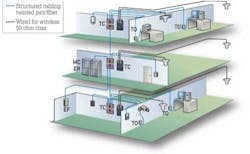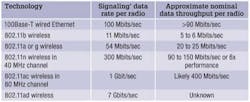By patrick mclaughlin
The Cisco Visual Networking Index (VNI) Global Mobile Data Traffic Forecast Update has become a frequently referenced document among professionals in the business of preparing communications systems for emerging applications. The update is part of the overall Cisco VNI Forecast, which the company describes as an ongoing initiative to track and forecast the impact of visual networking applications on global networks.
The Mobile Data Traffic Forecast Update was referenced more than once in a Web-delivered seminar hosted by Cabling Installation & Maintenance in April. In that seminar CommScope's (www.commscope.com) director of business development for in-building wireless systems, Greg Santee, and Oberon Inc.'s (www.oberonwireless.com) president, Scott Thompson, made reference to the VNI. Santee addressed in-building distributed antenna system (DAS) components, design and installation. Thompson discussed emerging wireless local area network (WLAN) technologies and the cabling systems needed to support them.
Eye-opening projections
The VNI was most recently updated in February 2011, for the period 2010-2015. In that update Cisco predicts that by 2015, the number of devices connected to Internet Protocol (IP) networks will be twice as high as the global population by 2015.
In CommScope's wired-for-wireless concept, 50-ohm coaxial cabling (black lines) is installed in the horizontal at the same time as twisted-pair or fiber-optic LAN cabling (blue lines). With a building prewired with cabling for a distributed antenna system, once the building owner decides to install DAS the work can be done within telecommunications rooms rather than in work areas, thereby minimizing disruption.
The VNI's statistics and predictions provide the backdrop for the Web seminar in which Santee and Thompson described wireless systems and the wires that support them. Santee referred to the VNI when he said, "Penetration by mobile subscribers is growing by leaps and bounds. There are now more than 5 billion mobiles on the market. In many countries penetration rates exceed 100 percent—there are more phones in some countries than the population of humans in that country."
While the growth of actual subscriber rates may taper off, mobile carriers' networks are becoming increasingly burdened by the fact that voice makes up far less of the traffic moving across those networks than it used to, and data applications including video makes up more of it.
DAS technology is put forth as a solution not only to the increasing bandwidth-consumption characteristics of mobile networks, but also to the practicalities of any mobile signals at all reaching inside buildings. Santee noted, "If we look at the structures that exist today, we have essentially built buildings that are difficult to cover from the classic macro cell site that sits outside the structure." He added that generally speaking, building owners "would like to make sure that from within a building [mobile] phone calls could be made, and that the quality of service meets that of an enterprise application"—no dropped calls as a mobile-device user makes their way through the building.
Then he described the reality that stands in opposition to that ideal. "Many buildings today are deep and cavernous, which makes it difficult for the RF signals to penetrate from a cell site. You also have subterranean areas," and radio-frequency signals do not do well penetrating the ground. Additionally, being environmentally conscious has at least one unintended consequence for mobile users inside a building. Santee observed that many structures built with the intention of achieving LEED (Leadership in Energy and Environmental Design) certification "contain ‘Low-E' glass, which reflects infrared energy so as not to drive up heating and cooling requirements. That glass offers 45 dB of attenuation for RF signals in the cellular band." In general, that is more attenuation than the signal receives from a building's concrete structure.
And depending on the height of a building, the problem may be too much rather than too little cell-site availability, he said. "If you have a very tall structure, you have a different problem. From above the 12th to 20th story, you have too many cell sites that are visible to mobile devices at that level. They're not sure which cell site to communicate through."
What DAS does
An investment in DAS technology solves these issues for building owners and users. "A well-planned multiband distributed antenna system will provide signals within the structure," Santee said, "which allows the enterprise customer to have certain flexibilities. They can negotiate wireless services from any operator, which has the potential to lower monthly service bills. It also maximizes the available services within the structure. If you set up the system so it supports all the wireless service providers, even if you as the enterprise company have a single wireless service provider for all business phones, your employers' personal phones, your vendors and your customers who use different providers will still have good service within your facility."
Santee's presentation discussed the differences between passive and active distributed antenna systems, including the options for using different cabling types to carry the signals to the individual antennas. About cabling choices overall, he said, "If we look at what services a customer best, the media that provides the most bandwidth ultimately is the winner in this situation, where we know we want to cover multiple service providers and multiple bands. With that in mind, in the riser singlemode fiber would be the preferred infrastructure as it has terahertz of bandwidth. It can take all possible frequencies in today's world, and in the future, across the same media.
"On the horizontal side, 50-ohm coaxial cable provides gigahertz of bandwidth, again supporting all the frequencies that are available today. And it offers lower RF loss than some of the 75-ohm CATV cables," which enables a DAS signal to go long distances from any intermediate crossconnect.
CommScope has promoted the idea of "Wired for Wireless," which essentially is the concept of prewiring a structure for the deployment of a DAS. Santee said the concept is meant to "reduce the cost associated with distributed antenna systems and in particular their installation." He said value lies in the fact that it is a standardized approach, similar to that of structured cabling for local area networks (LANs) in a building, where antennas can be laid out in a grid orientation fed from intermediate crossconnects. The DAS wiring system can be installed simultaneously with other structured cabling. Taking this approach "eliminates costs associated with complex RF designs for antenna placements, minimizes installation cost by having it concurrent with structured cabling, and ensures the system is futureproof enough to accommodate any service provider in any bands they desire," he explained. Additionally, "By electing to do this when you do structured cabling, you eliminate future business disruption. It can be installed by the same company at the same time," as a LAN structured cabling system.
High-speed 802.11
In his presentation, Oberon's Thompson also looked at the growing trend of data signals, including video, being sent over mobile devices. He looked closely at how the expected continuation of this trend will affect in-building 802.11-based WLANs.
Currently 802.11n is the state of the art. Many 802.11n-compliant products have penetrated the market, which Thompson described as "fairly mature."
Two sets of higher-speed WLAN specifications are under development within the Institute of Electrical and Electronics Engineers (IEEE; www.ieee.org): 802.11ac and 802.11ad. Thompson provided some insight into each. He said 802.11ac will provide "very high throughput at less than 6 GHz. In the U.S. there is nearly 500 MHz available for unlicensed use between 5 and 6 GHz." The original timeline of the 802.11ac standard has its approval scheduled for December 2012, and Thompson said it likely would be some time after that before product is commonly available. "It would be backward-compatible with 802.11n devices at 5 GHz," he said.
He then described 802.11ad as "a little different story. It takes advantage of a lot of available unlicensed spectrum at 60 GHz," he explained. The original timeframe also projects a December 2012 approval for 802.11ad, and products likely to become available sometime thereafter. But Thompson noted, "Because this operates at 60 GHZ it is a millimeter-wave frequency. There is not a lot of propagation through walls." He said he envisions 802.11ad being used primarily as an in-room networking system. At the physical layer it will not be interoperable with 802.11n products.
Addressing the capabilities that cabling systems will need in order to support 802.11ac and 802.11ad wireless transmission (as well as what is needed to support today's WLAN technologies) Thompson reminded, "It's important to understand the differences between signaling data rate—which is the over-the-air modulation rate commonly used to specify your wireless products—versus the TCP/IP data throughput rate that you would measure at the Ethernet connector. There is quite a difference." The table on page 34 is taken from Thompson's presentation and shows the signaling rate and nominal throughput rate for WLAN technologies as well as 100Base-T wired Ethernet.
On the edge
Thompson advised that users planning to deploy such high-speed wireless systems should ensure their edge switches are capable of these access points' uplink speeds. He used the example of a deployment of 48 dual-radio 802.11n access points. With each access point capable of 225-Mbit/sec transmission, at a 20:1 oversubscription factor, the uplink must be capable of 540 Mbits/sec—in which case a Gigabit-speed link would be adequate.
Thompson pointed out, however, "If we replaced the 48 802.11n access points with 802.11ac access points, which now may have a peak data rate of 400 to 500 Mbits/sec apiece, and use that same 20:1 oversubscription factor, it looks like my uplink has a requirement in excess of 1 Gbit/sec."
He advised that when calculating interconnection speeds for these coming wireless technologies, users would, "have to take a close look, based on your network design assumptions of what the impact is on the network infrastructure—particularly the uplinks from your edge switches."
Santee's comment is likely to ring true: The media that provides the most bandwidth ultimately is the winner.
Patrick McLaughlin is chief editor of Cabling Installation & Maintenance.

